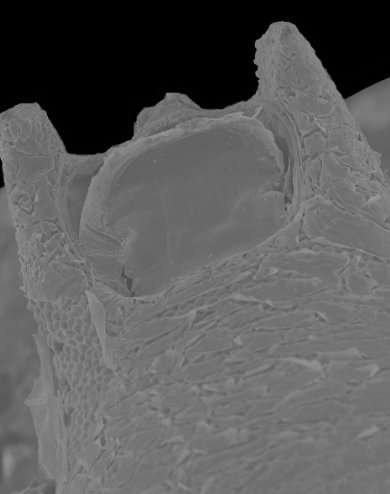Researchers find new unknown Bryozoa genera and species below 1000 meters in the Southwestern Atlantic

A scientific team has discovered 20 new species and two genera for unknown Bryozoa below 1000 meters in the Southwestern Atlantic, according to an article published in the journal Zootaxa by first author Blanca Figuerola from the University of Barcelona and collaborators.
Bryozoa are aquatic and colonial invertebrates that can produce mineralized skeletons. This is the largest identification of new bryozoan species below 1000 meters, the continental slope of the Argentine Patagonia, an area where most identified species had previously been found above 500 meters. The new species were collected during five oceanographic campaigns from 2008 to 2010, involving IEO's ATLANTIS Project on board the research vessel Miguel Oliver. The researchers explored 25 sampling sites between 138 and 1650 meters deep in the Southwestern Atlantic.
This area is one of the most productive marine ecosystems in the Southern Hemisphere due the confluence of two of the most powerful wind-driven currents: the Falkland Current, which is quite rich in nutrients, and the subtropical Brazil Current. In particular, the current of the Malvines is a branch of the Antarctic Circumpolar Current, which flows northward along the continental shelf of Argentina under 800 or 1000 meters to about latitude 30º to 40º S, where it is deflected eastward after meeting the warm southward-flowing Brazil Current.
When these powerful marine currents converge, there is a high biological production, promoting the growth of benthic invertebrates. "Therefore, this area contains particular species with a wide range of distributions and adaptations to fluctuating conditions, resulting from the influence of these subtropical and subantarctic waters," says Figuerola.
The findings of two genera (Amynaskolia and Biconcavus) and 20 new species add new chapters to the inventory of the regional biodiversity of Bryozoa in the Southwestern Atlantic. "In these areas, studies on the biodiversity of marine invertebrates are needed, mainly at slope and abyssal depths. For now, some of the best-known benthic invertebrates in this region are molluscs, echinoderms and cnidarians," says the researcher.
Some of the species belong to genera from which only two other species were previously known—in particular, the Ipsibuffonella umbonata, Membranicellaria balanyai, and Mawatarius avilae.
Curiously, the new species Biconcavus batmani possesses lateral formations that resemble the mask of Gotham City vigilante Batman. In the case of Malakosaria cecilioi of the Malakosaria genus, each zooid presents two oval excavations and one ascopore resembling a smiling face. All these new specimens were delivered to the Animal Biodiversity Resource Center (CRBA) of the UB.
Studying the biodiversity in the continental slope and the abyssal plain of the Patagonian and Antarctic regions is essential to completing the taxonomy and biogeography of some lineages that inhabit these unique ecosystems. The new findings will also provide perspective on the study of comparative diversity among invertebrate communities from the last separated fragments of Gondwana, the ancient supercontinent. This is, for example, the case of Spigaleos genus and the species Arachnopusia tubula, which were previously reported only from Antarctica; the genera Ipsibufonella, previously known to be only in tropical and subtropical areas, and Mucropetraliella, which was identified in areas outside the Patagonia.
Blanca Figuerola says, "The findings of Arachnopusia tubula, a species that shows a wide bathymetric range, supports our hypothesis on the polar front, which was reported in previous studies. This oceanographic barrier, the limit between the Austral Ocean and its surrounding waters, is not as impermeable as originally thought. Therefore, bryozoan colonies can be attached to drifting natural substrates or marine debris of anthropogenic origin (algae, plastics, etc.), and can spread fast through rafting (moving on floating objects) at a regional or global level."
The discovery of new marine invertebrate species in South America has rapidly increased since the mid-18th century. The new species were found in the area of eastern Patagonia. In other studies, the UB-IRBio researcher and other experts enlarged the catalogue of the benthic fauna in the South Atlantic with the identification of more than 180 bryozoan species.
"Many studies on the biodiversity in the area of the continental slope and abyssal plains are to be done yet. We know some bryozoan genera can incorporate significant amounts of magnesium to their skeletons; therefore, they are more soluble and more susceptible to the oceanic acidification than skeletons containing lower magnesium levels. It will be necessary to carry out studies on the distribution, abundance and mineralogy to assess whether these species are suitable as model organisms to study the effects of climate change in oceans," concludes Blanca Figuerola.
More information: BLANCA FIGUEROLA et al. New deep Cheilostomata (Bryozoa) species from the Southwestern Atlantic: shedding light in the dark, Zootaxa (2018). DOI: 10.11646/zootaxa.4375.2.3
Journal information: Zootaxa
Provided by University of Barcelona




















